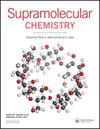Solid-state lattice effects on high-spin Mn(III) complexes with hexadentate Schiff-base ligand
IF 2.6
4区 化学
Q3 CHEMISTRY, MULTIDISCIPLINARY
引用次数: 1
Abstract
ABSTRACT This paper reports the syntheses, crystal structures, magnetics and spectroscopic properties of high-spin (HS) salts of formula [Mn(salk-N-1,5,8,12)]Y·S (Y = AsF6 for 1, Y = BF4, S = CH3OH for 2, Y = PF6, S = CH3OH for 3), where (salk-N-1,5,8,12)2− (2,2ʹ-((2E,14E)-3,7,10,14-tetraazahexadeca-2,14-diene-2,15-diyl)diphenolate) is a hexadentate Schiff-base ligand. Crystal structural analysis indicates that the extensive hydrogen bonds play a primary role in stabilisation of their HS states. As an aid to understanding this behaviour, the crystal structure of the known spin crossover compound [Mn(sal-N-1,5,8,12)]AsF6 (4) has been re-examined. To understand the impact of intermolecular forces to the different magnetic behaviours of salts 1 and 4, we evaluate of their supramolecular structures and confirm that intermolecular interactions can significantly affect the cooperativity. Furthermore, electrochemical studies on 1 and 4 shows that the choice of spin state is controlled by the solid-state lattice effects, i.e. cooperativity rather than molecular electronic effect. Graphical abstract六齿希夫碱配体高自旋Mn(III)配合物的固态晶格效应
摘要本文报道了式[Mn(salk- n -1,5,8,12)]Y·S (Y = AsF6为1,Y = BF4, S = CH3OH为2,Y = PF6, S = CH3OH为3)的高自旋(HS)盐的合成、晶体结构、磁性和光谱性质,其中(salk- n -1,5,8,12)2−(2,2′′-(2E,14E)-3,7,10,14-四氮杂十六烷基-2,14-二烯-2,15-二基)二酚酸盐为六齿状希夫碱配体。晶体结构分析表明,广泛的氢键对其HS态的稳定起主要作用。为了帮助理解这种行为,我们重新研究了已知的自旋交叉化合物[Mn(sal- n -1,5,8,12)]AsF6(4)的晶体结构。为了了解分子间作用力对盐1和盐4不同磁性行为的影响,我们评估了它们的超分子结构,并证实分子间相互作用可以显著影响协同性。此外,对1和4的电化学研究表明,自旋态的选择是由固态晶格效应即协同性控制的,而不是由分子电子效应控制的。图形抽象
本文章由计算机程序翻译,如有差异,请以英文原文为准。
求助全文
约1分钟内获得全文
求助全文
来源期刊

Supramolecular Chemistry
化学-化学综合
CiteScore
3.60
自引率
3.00%
发文量
5
审稿时长
2.7 months
期刊介绍:
Supramolecular Chemistry welcomes manuscripts from the fields and sub-disciplines related to supramolecular chemistry and non-covalent interactions. From host-guest chemistry, self-assembly and systems chemistry, through materials chemistry and biochemical systems, we interpret supramolecular chemistry in the broadest possible sense. Interdisciplinary manuscripts are particularly encouraged. Manuscript types include: high priority communications; full papers; reviews, and; Methods papers, techniques tutorials highlighting procedures and technologies that are important to the field. We aim to publish papers in a timely fashion and as soon as a paper has been accepted and typeset it will be published in electronic form on the Latest articles section of the website. The two most important review criteria are that the paper presents high-quality work that fits generally into the broad spectrum of activities in the supramolecular chemistry field. Under normal circumstances, Supramolecular Chemistry does not consider manuscripts that would be more suitable in a highly specialized journal. This includes, but is not limited to, those based mostly or exclusively on topics such as solid state/X-ray structures, computational chemistry, or electrochemistry. .
The two most important review criteria are that the paper presents high-quality work that fits generally into the broad spectrum of activities in the supramolecular chemistry field.
 求助内容:
求助内容: 应助结果提醒方式:
应助结果提醒方式:


